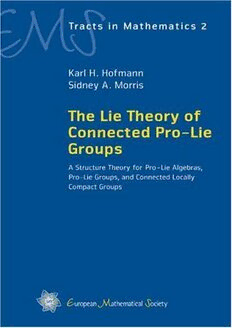Download The Lie Theory of Connected Pro-Lie Groups PDF Free - Full Version
Download The Lie Theory of Connected Pro-Lie Groups by Karl H. Hofmann and Sidney A. Morris in PDF format completely FREE. No registration required, no payment needed. Get instant access to this valuable resource on PDFdrive.to!
About The Lie Theory of Connected Pro-Lie Groups
Lie groups were introduced in 1870 by the Norwegian mathematician Sophus Lie. A century later Jean Dieudonn?© quipped that Lie groups had moved to the center of mathematics and that one cannot undertake anything without them. If a complete topological group $G$ can be approximated by Lie groups in the sense that every identity neighborhood $U$ of $G$ contains a normal subgroup $N$ such that $G/N$ is a Lie group, then it is called a pro-Lie group. Every locally compact connected topological group and every compact group is a pro-Lie group. While the class of locally compact groups is not closed under the formation of arbitrary products, the class of pro-Lie groups is. For half a century, locally compact pro-Lie groups have drifted through the literature, yet this is the first book which systematically treats the Lie and structure theory of pro-Lie groups irrespective of local compactness. This study fits very well into the current trend which addresses infinite-dimensional Lie groups. The results of this text are based on a theory of pro-Lie algebras which parallels the structure theory of finite-dimensional real Lie algebras to an astonishing degree, even though it has had to overcome greater technical obstacles. This book exposes a Lie theory of connected pro-Lie groups (and hence of connected locally compact groups) and illuminates the manifold ways in which their structure theory reduces to that of compact groups on the one hand and of finite-dimensional Lie groups on the other. It is a continuation of the authors' fundamental monograph on the structure of compact groups (1998, 2006) and is an invaluable tool for researchers in topological groups, Lie theory, harmonic analysis, and representation theory. It is written to be accessible to advanced graduate students wishing to study this fascinating and important area of current research, which has so many fruitful interactions with other fields of mathematics.
Detailed Information
| Author: | Karl H. Hofmann and Sidney A. Morris |
|---|---|
| Publication Year: | 2007 |
| ISBN: | 9783037190326 |
| Pages: | 695 |
| Language: | English |
| File Size: | 3.712 |
| Format: | |
| Price: | FREE |
Safe & Secure Download - No registration required
Why Choose PDFdrive for Your Free The Lie Theory of Connected Pro-Lie Groups Download?
- 100% Free: No hidden fees or subscriptions required for one book every day.
- No Registration: Immediate access is available without creating accounts for one book every day.
- Safe and Secure: Clean downloads without malware or viruses
- Multiple Formats: PDF, MOBI, Mpub,... optimized for all devices
- Educational Resource: Supporting knowledge sharing and learning
Frequently Asked Questions
Is it really free to download The Lie Theory of Connected Pro-Lie Groups PDF?
Yes, on https://PDFdrive.to you can download The Lie Theory of Connected Pro-Lie Groups by Karl H. Hofmann and Sidney A. Morris completely free. We don't require any payment, subscription, or registration to access this PDF file. For 3 books every day.
How can I read The Lie Theory of Connected Pro-Lie Groups on my mobile device?
After downloading The Lie Theory of Connected Pro-Lie Groups PDF, you can open it with any PDF reader app on your phone or tablet. We recommend using Adobe Acrobat Reader, Apple Books, or Google Play Books for the best reading experience.
Is this the full version of The Lie Theory of Connected Pro-Lie Groups?
Yes, this is the complete PDF version of The Lie Theory of Connected Pro-Lie Groups by Karl H. Hofmann and Sidney A. Morris. You will be able to read the entire content as in the printed version without missing any pages.
Is it legal to download The Lie Theory of Connected Pro-Lie Groups PDF for free?
https://PDFdrive.to provides links to free educational resources available online. We do not store any files on our servers. Please be aware of copyright laws in your country before downloading.
The materials shared are intended for research, educational, and personal use in accordance with fair use principles.

